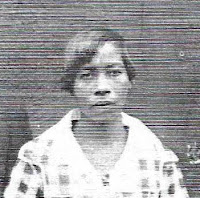 |
Armstrong Road
Jasper County, Texas |
I grew up in a small farming community in Deep
East Texas called Peachtree. In the early part of
the 1900’s my great-grandfather, Joe Armstrong (we called him Papa), and his sons purchased about fifty acres of land northwest
of Jasper, Texas. He and two of his older sons built homes facing the main
road. Another son built his home on the back portion of the property. But Papa's house always seemed the grandest to me. There were cement steps lined by red bricks that lead to the wide front porch. Papa called the porch a "garrett". All I knew was that porch was everything. Papa and Mama R. V. sat up there like rulers of their own little kingdom. With pieces of cardboard they fanned away the heat, flies, and mosquitoes with one hand, all the while admonishing and directing us children to get out of the road with the other hand. They waved to the occasional pedestrian walking the dusty red dirt road. The lucky traveler was invited onto the porch to sit for a few minutes. One of us children would be sent to get the thirsty visitor a glass of ice water. And then, with the same pieces of cardboard that fanned away the flies and mosquitoes, we were shooed away while the adults talked.
There
were other men in Papa’s family who bought land in the same area around that
time: Manuel Armstrong, Robert Wysinger, Otto Shelby, and Linkfield Hadnot. Dusty dirt roads wound in and around small clusters of tiny houses in the dark, lush
pine forest. Each little group of homes was usually inhabited by close family
members, but the family groups were all part of the larger extended family.
Manuel was Papa’s older brother, Otto was married to Manuel’s daughter, Ruth, and
Robert Wysinger was married to Tay Armstrong, a cousin to Papa. It was a community of family. They worked together, celebrated together, mourned together, and in a tiny church down the road, they prayed together.
 |
| Joe and R.V. Armstrong |
Papa was a proud man and carried himself in a
dignified manner. He was tall and thin with dark brown skin and fine facial features. In
an ex-slave narrative his brother, Manuel, described himself and his family
as “pure Negroes”. Papa, being the youngest in his family, seemed honored by
that distinction and wore it proudly. When I knew him he was an old man in his
eighties, but he always dressed the part of a Southern gentleman farmer. His
white shirts were heavily starched and the collars were stiff, his khaki pants
creased, his high top black shoes shinned, and his white Panama hat held a special
place in his chifferobe.
 |
| Blane Armstrong |
In his old age Papa's mind and body started to fail him. He was taken care of by his
daughter, Eva (Auntie), who was unmarried and taught at our elementary
school. While she was at work during the day his son, Blane, sat with him.
Sometimes, though, when neither of them could be with Papa, we children were
assigned to “watch” Papa. The things Papa did and said often made us laugh. We
thought all old people were like him. At other times Papa’s dementia caused him
to be delusional and to hallucinate. Once he demanded a glass of water to
take to a man on the television show “Gunsmoke” because the man was dying of
thirst. He got up from his chair and started toward the front door. We couldn't get him to sit back down, so we had to call Uncle Blane to come and calm him down. It’s
funny now, but for ten or twelve year old kids it was a little unnerving.
When Papa passed away in January 1967 I had not
yet reached twelve years old. He had spent the last years of his life being bathed,
shaved, and fed by others. His starched white shirts and creased khaki pants
hung untouched in his chifferobe. By then he only wore pajamas and dragged his slipper clad
feet the few feet from his bed to his recliner. Dementia had reduced my once
proud great-grandfather to the status of a fearful child. I don’t remember the details of Papa’s funeral. However,
I do remember the car ride home from the cemetery. My grandmother asked me what I was crying. I told her I didn’t
know. Maybe at the time I thought I was suppose to cry. Or maybe it was because
somewhere inside of me I knew I was going to miss my great-grandfather’s
striking image in his starched clothes, the tales he told, those Camel cigarettes without a filter he smoked, and even his delusional ramblings. Although I was only eleven year old, I knew things would never be the same in Peachtree without Papa.









